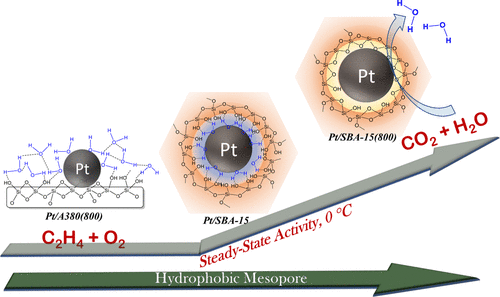当前位置:
X-MOL 学术
›
ACS Catal.
›
论文详情
Our official English website, www.x-mol.net, welcomes your
feedback! (Note: you will need to create a separate account there.)
Water-Resistant Pt Sites in Hydrophobic Mesopores Effective for Low-Temperature Ethylene Oxidation
ACS Catalysis ( IF 11.3 ) Pub Date : 2020-11-02 , DOI: 10.1021/acscatal.0c02816 Shazia S. Satter 1 , Jun Hirayama 1 , Hirokazu Kobayashi 1 , Kiyotaka Nakajima 1 , Atsushi Fukuoka 1
ACS Catalysis ( IF 11.3 ) Pub Date : 2020-11-02 , DOI: 10.1021/acscatal.0c02816 Shazia S. Satter 1 , Jun Hirayama 1 , Hirokazu Kobayashi 1 , Kiyotaka Nakajima 1 , Atsushi Fukuoka 1
Affiliation

|
The structure–activity relationship of silica-supported Pt catalysts in aerobic oxidation of 50 ppm ethylene was studied at 0 °C with a fixed-bed flow reactor and in situ characterization techniques using Fourier-transform infrared (FTIR) spectroscopy. The activity of all Pt catalysts examined here decreased by water molecules formed during stoichiometric oxidation of ethylene and became stable steadily. A mesoporous silica-supported Pt catalyst improved its steady-state activity after calcination of the support in air at 800 °C, whereas no such effect was observed for a nonporous silica support. CO-pulse titration, H2O adsorption measurements, 29Si MAS NMR, and in situ FTIR along with catalytic activity studies revealed that the activity of the mesoporous silica-supported Pt catalyst is higher than that of nonporous silica-supported ones, despite showing similar hydrophobicity and low Pt dispersion. In situ characterization using CO as a molecular probe indicates that a part of the Pt surface inside hydrophobic mesopores is not involved in the hydrogen-bonding network among physisorbed water molecules and surface SiOH groups even after full hydration of the catalyst surface, and bare Pt sites are expected to work more effectively for ethylene oxidation. Such a “hydrophobic Pt surface” can only be formed on a hydrophobic mesoporous silica support, which is probably because of Pt nanoparticles surrounded by a hydrophobic siloxane network entirely. A unique environment derived from the condensed siloxane network and restricted mesopores contributes largely to the high activity of Pt nanoparticles for low-temperature oxidation of trace ethylene.
中文翻译:

疏水性中孔中的耐水Pt位点对低温乙烯氧化有效
在0°C下使用固定床流动反应器和使用傅里叶变换红外光谱(FTIR)的原位表征技术研究了二氧化硅负载的Pt催化剂在50 ppm乙烯的好氧氧化中的结构活性关系。在此检查的所有Pt催化剂的活性都因乙烯的化学计量氧化过程中形成的水分子而降低,并逐渐稳定。介孔二氧化硅负载的Pt催化剂在800℃的空气中煅烧载体后提高了其稳态活性,而无孔二氧化硅载体则没有观察到这种效果。CO脉冲滴定,H 2 O吸附测量,29 Si MAS NMR和原位FTIR和催化活性研究表明,尽管具有相似的疏水性和低Pt分散性,但介孔二氧化硅负载的Pt催化剂的活性高于无孔二氧化硅负载的Pt催化剂。原位使用CO作为分子探针的表征表明,即使在催化剂表面完全水合后,疏水性中孔内的Pt表面的一部分也不参与物理吸附水分子和表面SiOH基团之间的氢键网络以更有效地进行乙烯氧化。这样的“疏水性Pt表面”只能在疏水性中孔二氧化硅载体上形成,这可能是由于Pt纳米颗粒完全被疏水性硅氧烷网络所包围。源自缩合硅氧烷网络和受限的中孔的独特环境在很大程度上有助于Pt纳米颗粒对痕量乙烯的低温氧化。
更新日期:2020-11-21
中文翻译:

疏水性中孔中的耐水Pt位点对低温乙烯氧化有效
在0°C下使用固定床流动反应器和使用傅里叶变换红外光谱(FTIR)的原位表征技术研究了二氧化硅负载的Pt催化剂在50 ppm乙烯的好氧氧化中的结构活性关系。在此检查的所有Pt催化剂的活性都因乙烯的化学计量氧化过程中形成的水分子而降低,并逐渐稳定。介孔二氧化硅负载的Pt催化剂在800℃的空气中煅烧载体后提高了其稳态活性,而无孔二氧化硅载体则没有观察到这种效果。CO脉冲滴定,H 2 O吸附测量,29 Si MAS NMR和原位FTIR和催化活性研究表明,尽管具有相似的疏水性和低Pt分散性,但介孔二氧化硅负载的Pt催化剂的活性高于无孔二氧化硅负载的Pt催化剂。原位使用CO作为分子探针的表征表明,即使在催化剂表面完全水合后,疏水性中孔内的Pt表面的一部分也不参与物理吸附水分子和表面SiOH基团之间的氢键网络以更有效地进行乙烯氧化。这样的“疏水性Pt表面”只能在疏水性中孔二氧化硅载体上形成,这可能是由于Pt纳米颗粒完全被疏水性硅氧烷网络所包围。源自缩合硅氧烷网络和受限的中孔的独特环境在很大程度上有助于Pt纳米颗粒对痕量乙烯的低温氧化。











































 京公网安备 11010802027423号
京公网安备 11010802027423号